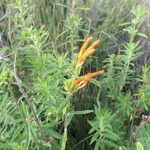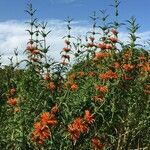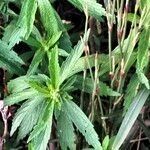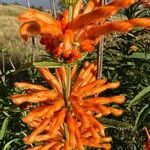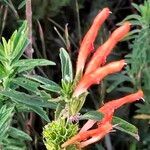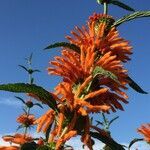Perennial shrub, 2-5 m high, base woody; densely pubescent, hairs antrorse. Leaves petiolate, linear, 50-100 x 10-20 mm, base and apex acute, margins serrate in distal half; upper surface green and rough, lower surface more densely pubescent. Inflorescence simple; verticillasters 3-11, compact, subsperical, 25-40 mm in diam. Flowers covered by orange-coloured hairs. Calyx 12-15 mm long; teeth 10, 0.9-3.0 mm long, Sub-Equal, spreading. Corolla: tube bent forward, 26-30 mm long, fringed on inside; lobes of lower lip 4.2-7.2 mm long, lateral ones retuse. Flowering time all year.
Shrub, 2-5 m high. Stems erect, densely pubescent, striate by elongated lenticels. Leaves petiolate; blade linear, 50-100 x 10-20 mm, apex and base acute, margins serrate in upper part of blade, upper surface green and rough, lower surface more densely pubescent; petioles up to 10 mm long, densely hairy. Flowers: in terminal, axillary, subspherical inflorescences of 3-11 verticils; bracts 40-80 mm long; calyx 10-toothed, teeth subequal, < 15 mm long; corolla 40-49 mm long, lower lip reflexed on tube, lip with 3 separate lobes, densely pubescent, orange; Feb.-May.
A shrub. It grows 2-5 m tall. It forms branches from a thick woody base. They are densely hairy. The leaves are 5-10 cm long by 1-2 cm wide. They have teeth on the upper half. The leaves are green and rough on the upper surface and hairy underneath. The flowers are in groups or 3-11. The small nuts are 5-6 mm long by 1.6-1.9 mm wide.
Roughly hairy shrub to 500 cm. Leaves narrowly lanceolate, toothed. Flowers in axillary verticils, calyx subequally toothed, corolla with lower lobes reflexed, velvety orange, 40-49 mm long.
